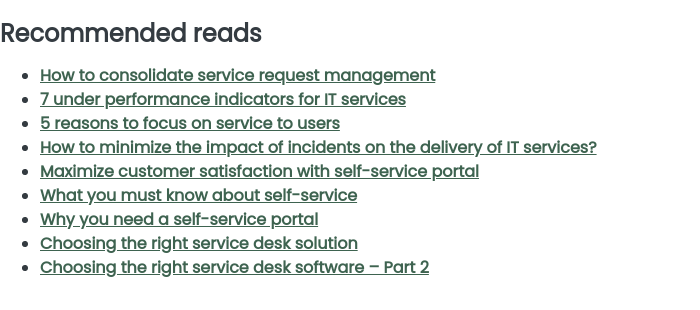
Effective service management relies on a clear and well-defined structure. A service catalogue tailored to each department enhances the customer experience and optimizes internal processes. With ITSM, request management becomes more straightforward. It aligns your teams and services in a structured, proactive, and documented manner.
Challenges of internal services without a structured catalogue
Without a well-defined service catalogue, departments face several challenges:
- Complicated tracking: Dispersed requests make tracking difficult, increasing the risk of errors or oversights.
- Extended delays: The lack of clear processes can lead to delays in handling requests.
- Loss of visibility: Getting an overview of ongoing requests and their status is challenging without centralization.
A good service catalogue begins by clearly distinguishing the different types of services offered. These can be divided into two main categories.
The first is business services, which may include requests for human resources, legal services, finance, material resources, etc.
Then, there are technical services, which include IT services, infrastructure management, and maintenance.
Each service is then organized into distinct catalogues to facilitate employees' understanding and use. For example, an employee looking for an IT service will refer to the IT resources catalogue. Other users with requests related to human resources will use the HR catalogue. This segmentation improves accessibility, the speed of requests, and the management processes of requests on the self-service portal.
“If, for example, several requests come from the leisure department, we will come once to do all the necessary work, which allows us to better organize our interventions.”
Jean Bissonnette
IT Director – City of Candiac, Canada
The importance of an online service catalogue
An online service catalogue offers a solution to these challenges by enabling:
- Centralization of requests: All requests are gathered in one place, making tracking and management more effortless.
- Automation of processes: Repetitive tasks can be automated, freeing up time for higher-value activities.
- Improvement in efficiency: Processes are standardized, reducing delays and increasing internal customer satisfaction.
The significance of a unified service portal
Although these catalogues are distinct, they remain interconnected. For example, a request for new IT equipment might require budget approval from the finance department. ITSM naturally creates these links, thus facilitating collaboration between different departments.
A unified service portal offers several benefits for your organization. It simplifies user searches, allowing them to quickly find the right form without navigating through multiple systems. The well-defined catalogue highlights the services offered and clarifies expectations, enhancing the relationship with users.
“We now have a centralized and personalized portal. Employees and citizens can make a request, quickly receive an acknowledgment of receipt, and follow up easily.”
Vincent Marcoux
Head of IT – City of Belœil, Canada
It can also contribute to the brand image by providing smooth and efficient service, strengthening the organization's credibility. Finally, it encourages employee loyalty, as they will naturally return to the platform for future requests.
The benefits of ITSM for each department
ITSM helps each department better manage its services by ensuring effective tracking of requests. It facilitates team collaboration, avoids friction, and clarifies processes, reducing errors. With real-time visibility, requests are processed more quickly. Employees can also track the progress of their requests with complete transparency. Precise statistics allow for trend analysis to improve request management continuously. In short, multiple catalogues per department offer you the following:
- Customized catalogues: Each department can have a catalogue tailored to its needs.
- Increased visibility: Managers have an overview of requests, making decision-making easier.
- Improved collaboration: Teams can work together more cohesively thanks to integrated processes.
Meeting the organization's overall needs
A good ITSM system goes beyond just managing requests. It also allows for tracking equipment, improving internal communication, and simplifying the integration of new employees. It facilitates the management of remote work equipment, ensures complaint tracking, and enables better project management.
Concrete examples of using a non-IT service catalogue
A service catalogue simplifies administrative management. For instance, an employee can submit an insurance request based on their union without endless email exchanges.
A guided form makes reporting a workplace accident easier and ensures better case tracking. Filing a grievance becomes simpler as the platform directly identifies the responsible party and automates the subsequent steps. With a straightforward interface and suitable filters, ITSM facilitates access to services and offers a smooth and efficient experience.
Conclusion
A well-structured service catalogue is a powerful tool for optimizing operations and enhancing employee satisfaction. ITSM allows your organization to centralize, automate, and simplify request management while strengthening collaboration between departments. Providing employees with a smooth and efficient experience will enable you to optimize your resources and ensure more effective internal processes.








